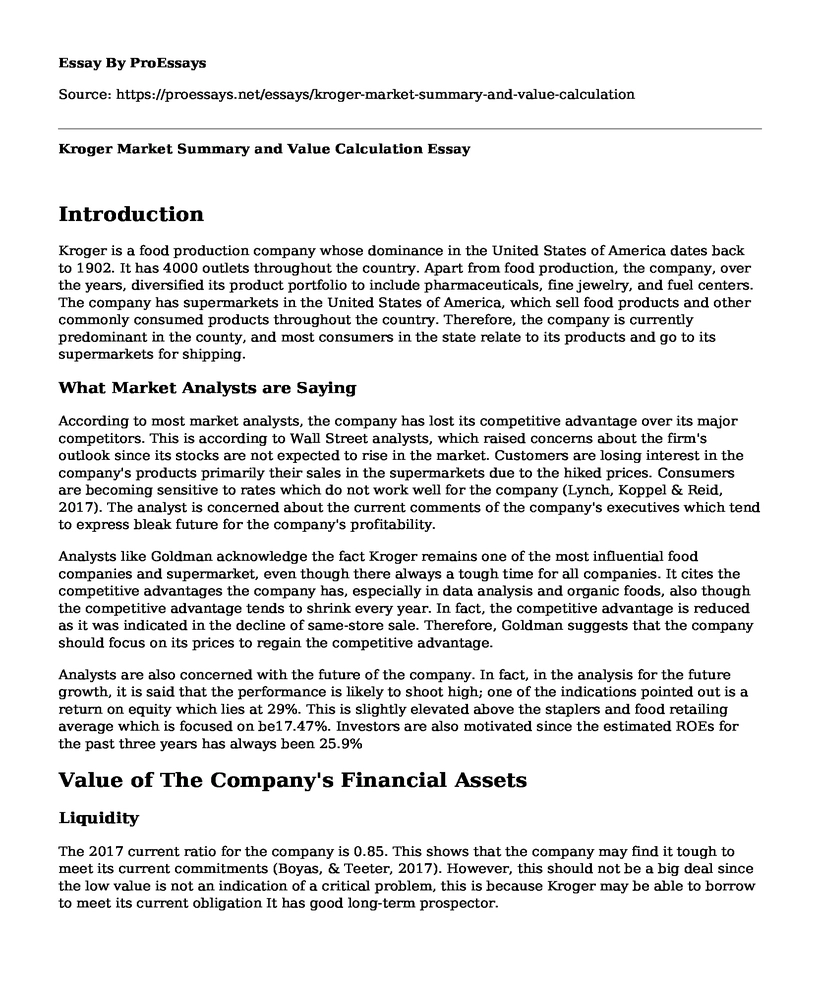Introduction
Kroger is a food production company whose dominance in the United States of America dates back to 1902. It has 4000 outlets throughout the country. Apart from food production, the company, over the years, diversified its product portfolio to include pharmaceuticals, fine jewelry, and fuel centers. The company has supermarkets in the United States of America, which sell food products and other commonly consumed products throughout the country. Therefore, the company is currently predominant in the county, and most consumers in the state relate to its products and go to its supermarkets for shipping.
What Market Analysts are Saying
According to most market analysts, the company has lost its competitive advantage over its major competitors. This is according to Wall Street analysts, which raised concerns about the firm's outlook since its stocks are not expected to rise in the market. Customers are losing interest in the company's products primarily their sales in the supermarkets due to the hiked prices. Consumers are becoming sensitive to rates which do not work well for the company (Lynch, Koppel & Reid, 2017). The analyst is concerned about the current comments of the company's executives which tend to express bleak future for the company's profitability.
Analysts like Goldman acknowledge the fact Kroger remains one of the most influential food companies and supermarket, even though there always a tough time for all companies. It cites the competitive advantages the company has, especially in data analysis and organic foods, also though the competitive advantage tends to shrink every year. In fact, the competitive advantage is reduced as it was indicated in the decline of same-store sale. Therefore, Goldman suggests that the company should focus on its prices to regain the competitive advantage.
Analysts are also concerned with the future of the company. In fact, in the analysis for the future growth, it is said that the performance is likely to shoot high; one of the indications pointed out is a return on equity which lies at 29%. This is slightly elevated above the staplers and food retailing average which is focused on be17.47%. Investors are also motivated since the estimated ROEs for the past three years has always been 25.9%
Value of The Company's Financial Assets
Liquidity
The 2017 current ratio for the company is 0.85. This shows that the company may find it tough to meet its current commitments (Boyas, & Teeter, 2017). However, this should not be a big deal since the low value is not an indication of a critical problem, this is because Kroger may be able to borrow to meet its current obligation It has good long-term prospector.
The company's quick ratio:
Quick Ratio (A: Jan. 2017 = (Total Current Assets- Total Inventories) / Total Current Liabilities= (10340 - 6561) / 12860 = 0.29 This is an indication that the company can meet its obligations with its current liquid assets
Financial Leverage
D/E Ratio = Total Debt / Total Equity which is 24.76%. This is an indication of good performance of the company since it is slightly high above 20%
The return on investment capital for the financial year 2017 is 9.46%
Asset Management Ratio
- Total Debt to Total Equity - 210.17
- Total Debt to Total Capital - 67.76
- Total Debt to Total Assets - 37.51
- Long-Term Debt to Equity - 176.55
- Long-Term Debt to Total Capital - 56.92
Profitability
- Gross Margin - 20.37
- Operating Margin - 2.98
- Pretax Margin - 2.53
- Net Margin - 1.70
- Return on Assets - 5.41
- Return on Equity - 28.98
- Return on Total Capital - 9.88
- Return on Invested Capital - 11.18
Market value
- P/E Current - 13.31
- P/E Ratio (with extraordinary items) - 15.73
- P/E Ratio (without extraordinary items) - 16.31
- Price to Sales Ratio - 0.28
- Price to Book Ratio - 4.60
- Price to Cash Flow Ratio - 7.50
- Enterprise Value to EBITDA - 6.60
- Enterprise Value to Sales - 0.32
- Total Debt to Enterprise Value - 0.31
References
Boyas, E., & Teeter, R. (2017). Teaching Financial Ratio Analysis using XBRL. Developments in Business Simulation and Experiential Learning, 44(1).
Lynch, C., Koppel, K., & Reid, W. (2017). Sensory characteristics and consumer acceptance of black walnut gelato. International Journal of Food Science & Technology, 52(7), 1594-1603.
Warshawsky, D. N. (2016). Food waste, sustainability, and the corporate sector: Case study of a US food company. The Geographical Journal, 182(4), 384-394.
Cite this page
Kroger Market Summary and Value Calculation. (2022, Mar 29). Retrieved from https://proessays.net/essays/kroger-market-summary-and-value-calculation
If you are the original author of this essay and no longer wish to have it published on the ProEssays website, please click below to request its removal:
- Essay Sample on Relation of an Employee With Human Resource Department
- Should We Use Credit Cards? - Research Paper
- Article Analysis Essay on Moral Globalization and Its Discontents
- Essay Example on Valuing Bonds: Essential Components & Call Provisions
- Financial Analysis of Starbucks (2000-2005)
- Essay Example on US Foreign Policy: Shaping the Global Economic and Geopolitical System
- Paper Example on Curbing Healthcare Costs: Debates and Solutions







